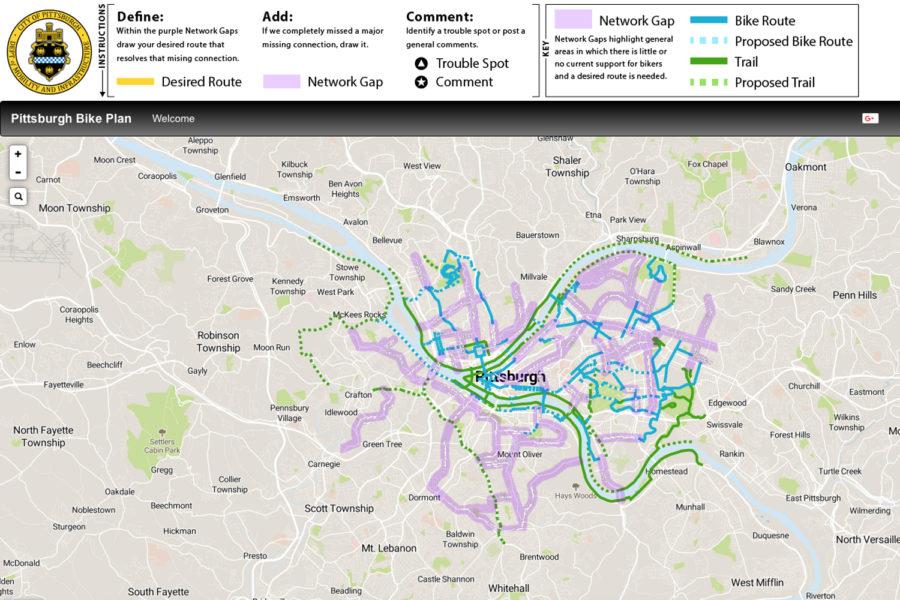Pittsburghers gear up for new bike plan
Screenshot via City of Pittsburgh/WikiMapping/Mapbox/OpenStreetMap
The City of Pittsburgh’s Department of Mobility and Infrastructure displays a map with current and proposed bike routes and trails throughout the City.
October 16, 2018
When the Department of Mobility and Infrastructure invited the community to give input on the newly proposed bike plan initiative on Oct. 10, a group of passionate Pittsburghers gathered to make their voices heard.
About 35 people gathered in the Manchester Citizen Corporation on Monday to attend the second of three meetings DOMI organized. The meetings — and an online portal — aim give average citizens a chance to discuss the future of Pittsburgh’s bike paths and trails and advocate for changes to the new plan, which includes building new bike infrastructure to connect to, and expand, already existing infrastructure with community input.
Kristin Saunders, the Principal Transportation Planner at DOMI, began the meeting with a presentation about the goals and basic details of the new bike plan, emphasizing the importance of feedback.
“We want to make sure the community is involved in all level of design,” Saunders said.
Pittsburgh completed its first bike plan initiative, which aimed to make Pittsburgh safer, more convenient and more accessible to bikers, in 1999. After almost 20 years, DOMI announced the City’s second plan to revolutionize its biking infrastructure.
Saunders said the ’99 plan focused on easily achieved objectives, and that the ongoing plan will take on more ambitious ones. The new plan’s first priority is to improve the biking experience for commuters. Some planned bike paths include one that runs along Fifth Avenue from downtown Pittsburgh into North Oakland, and another that connects Esplen to South Shore via Carson Street.
Saunders concluded her presentation and opened the floor, inviting audience members to share questions, concerns and suggestions about the bike plan.
Renee Rosensteel, 54, came to the meeting to advocate for bike lanes on Chateau Street in Manchester, where she lives. But during the open-floor discussion she raised the issue of vehicles parked in bike lanes. She asked how she could report such violations, and a police officer in the audience replied that she could call 911 — but that if the vehicle’s owner contested their ticket and the complainant didn’t come to court as a witness, the ticket would be dismissed.
“Oh, no, Rosensteel replied, “I’ll be there.”
Rosensteel said she once called 911 on a car parked in a bike lane and waited in the rain for the police, but she got frustrated and left before an officer arrived. She said she understood that the police have other priorities, but that the rules of the road need to be enforced.
“There are a lot of times where I will ride up behind someone and take a picture and report it. I do have places I have to go to,” she said. “[But] I’m not fooling around … give them a ticket.”
Retired electrical engineer and frequent biker Gerrold Green agreed with Rosensteel. The 73-year-old Central North Side resident said cars parked in bicycle lanes are a problem he frequently sees, and that police need to do more than just tell drivers to move along.
“Bicycles need their own space,” Green said. “I hope that the culture will change and it’ll take some enforcement.”
One audience member questioned whether better biking infrastructure was worth the investment, considering that resources could be spent elsewhere. Saunders defended the bike plan by calling attention to the 25 percent of households in the City that do not have access to a motor vehicle.
“We want to provide ways for people to get around without a car, because a lot of people don’t have access to a personal automobile,” Saunders said.
For Lynn Langford of Crafton Heights, there is no question that the benefits of building new bike paths and trails justify the costs. Langford is active with the West End community group, which promotes businesses and community activities in the West End — which in 2016 was found to be home to the most dangerous intersection in Pennsylvania.
She said she wants to see improvements in bike lanes around the West End circle in particular, which connects Carson Street and the West End Bridge. According to the online community input map, there are currently no plans for bike lanes in the West End Bridge area.
“Talk to anybody from the West End, we feel like we’re cut off from the City. If I want to go down Carson Street, I have to pick up my bike and carry it. The other option is to go through the circle with the cars.” Langford said. “West End is a community that keeps trying to revitalize. We would like to make it a destination.”
Alex Pazuchanics, DOMI’s Assistant Director for Planning, Policy and Permitting, said the bike plan is an opportunity for DOMI, as a relatively new organization, to articulate its values and make a difference in the lives of Pittsburghers.
“Everything that we do ties back to the needs of the community and the residents,” Pazuchanics said. “We want to give people options and choice in that process.”
Green said he appreciated DOMI’s efforts to involve the community in the decision-making process for bikers and the City’s bike plan. As a father and grandfather, he wants to see biking infrastructure improve and keep on improving for the sake of his children and grandchildren.
“It’s been slow and not always consistent and improving but it has been getting better,” Green said. “What you see now, a meeting like this, to talk about making improvements, wasn’t around in the nineties. It’s a good showing on the part of the City.”



